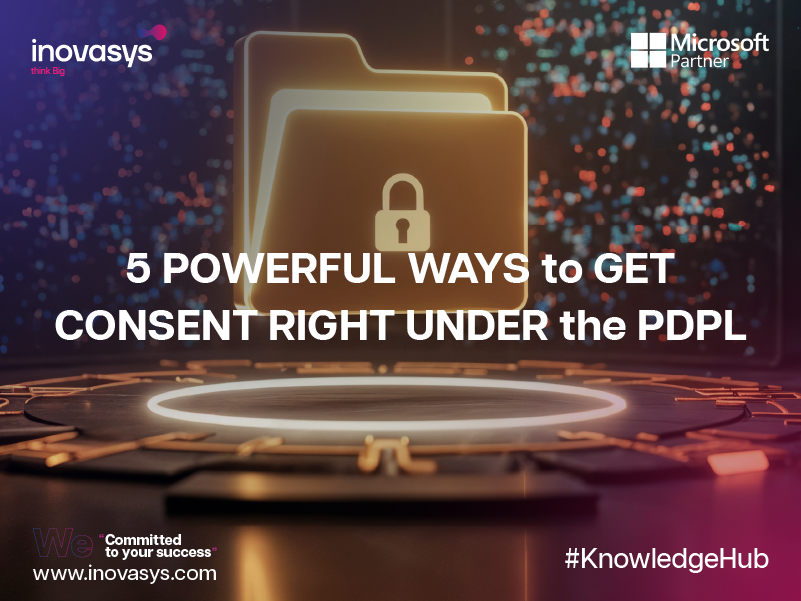Inovasys, founded in 2014, has been a leader in providing advanced technology solutions. By 2020, it became known as a service provider. The company aims to be the best partner for businesses looking to improve their operations with digital technology.
Articles & Press Release

5 POWERFUL WAYS to GET CONSENT RIGHT UNDER the PDPL
Welcome back! In our PDPL article, we explored the PDPL as the new rulebook for data privacy in the Kingdom. Today we focus on the cornerstone of every trusted digital relationship—Consent.
Think of the worst way someone could ask you on a date: they mumble, skip the details, and just assume you’ll say yes. Awkward, right? Asking for personal data without clear Consent is exactly the same. Under the PDPL, getting Consent is not just good manners—it’s the law. Here’s how to do it right.
1. Understand What Makes Consent Valid
For Consent to meet PDPL standards, it must be:
-
Freely Given: Users must have a real choice. For example, don’t force “You must agree to receive marketing emails to use this app.” That’s an ultimatum, not free Consent.
-
Specific: Ask permission for one purpose at a time. Instead of “Can we use your data for marketing?”, say “Can we send you weekly offers via email?” with a separate option for SMS alerts.
-
Unambiguous & Informed: Use clear, plain language explaining what data you collect, why, and how you’ll use it. No burying details in a 40-page “Terms and Conditions” document.
2. Learn From the Consent Hall of Fame vs. Hall of Shame
Hall of Shame – Don’t Make These Mistakes
-
Sneaky Pre-Checked Box: Users must tick boxes themselves. Pre-checked boxes are not valid Consent.
-
Hidden Consent: A single line in the privacy policy saying “By using our service, you agree to share your data” is deceptive and not informed.
-
All-or-Nothing Deal: Forcing users to share data unrelated to the service (like a calculator app demanding access to contacts) breaks PDPL rules.
Hall of Fame – Best Practices
-
Granular Checklist: Provide multiple unchecked boxes so users can select exactly what they allow.
-
Just-in-Time Explanation: A pop-up that says, “To find stores near you, we need access to your location. Is that okay?” right when the user clicks the button—clear and timely.
-
Easy Exit: Make withdrawing Consent as simple as giving it. If a user signed up with one click, they should be able to unsubscribe with one click.
3. Respect the “It’s Not You, It’s Me” Clause
Remember, Consent is not a lifetime contract. The PDPL requires that customers can change their minds easily. If they signed up with one click, unsubscribing should be just as fast. Don’t hide the unsubscribe button or demand a 10-page form. Good Consent practice means respecting the right to withdraw at any time.
4. Build Digital Trust Through Transparent Consent
Clear Consent builds credibility and long-term relationships. When people see you respect their privacy and explain how their data is used, they are far more likely to stay loyal to your brand. Transparency and honesty turn a legal requirement into a competitive advantage.
5. Make Consent Your Competitive Edge
Organizations that master Consent don’t just avoid penalties—they earn user loyalty. By embedding clear and transparent processes, you position your brand as trustworthy and customer-centric.
Key Takeaway
Treat asking for data like asking a favor from a friend. Be clear, honest, and respectful. Strong Consent practices are the foundation of digital trust—and under the PDPL, they are non-negotiable.
Frequently Asked Questions
1. What is Consent under the PDPL?
Consent is a clear, freely given, and informed agreement by an individual allowing a company to collect and process their personal data.
2. How can businesses collect valid Consent?
By using plain language, granular checklists, and ensuring users actively opt in without any pre-checked boxes.
3. Can users withdraw their Consent at any time?
Yes. The PDPL requires that withdrawing Consent be as simple as giving it—ideally with a single click or a straightforward process.
4. What happens if a company fails to obtain proper Consent?
Non-compliance can lead to penalties, legal action, and serious reputational damage for the organization.

